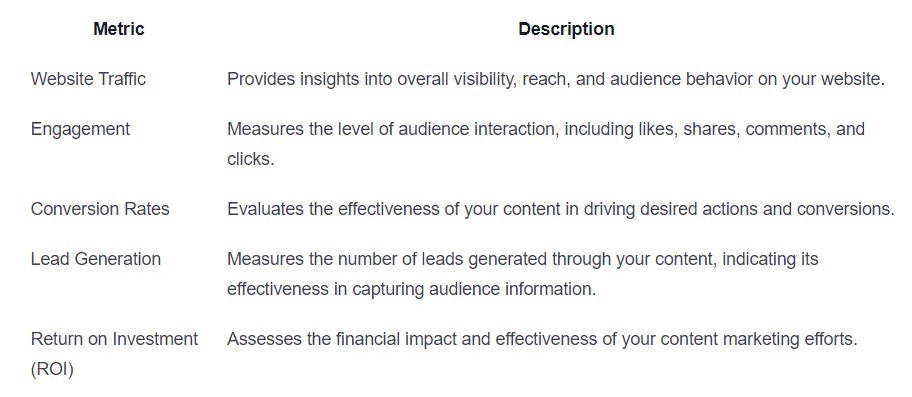How Long Should Blog Posts Be? The Ideal Blog Post Length
While there is no one-size-fits-all answer to how long a blog post should be, understanding the importance of content quality and the impact of bounce rate can provide insights.


How Long Should Blog Posts Be? The Ideal Blog Post Length
Understanding Blog Post Length
When it comes to blog post length, finding the right balance between quality and quantity is essential. While there is no one-size-fits-all answer to how long a blog post should be, understanding the importance of content quality and the impact of bounce rate can provide valuable insights.
Importance of Content Quality
Regardless of the length of a blog post, content quality should always be a top priority. High-quality content engages readers, provides value, and establishes credibility. It's essential to balance length with quality, ensuring that the content remains engaging and valuable to the reader throughout [1].
By focusing on content quality, you can capture and hold the attention of your audience, encouraging them to spend more time on your website. This can lead to increased user engagement, higher chances of social sharing, and improved search engine rankings.
Impact of Bounce Rate
Bounce rate refers to the percentage of visitors who leave a website after viewing only one page. For a single-page site like a blog, or other types of content that expect single-page sessions, a high bounce rate is considered normal, as users are expected to view only one page [2]. However, a high bounce rate can also indicate that the content did not meet the visitor's expectations or failed to provide the desired information.
The length of a blog post can influence the bounce rate. If the content is too short and lacks depth, readers may not find it valuable enough to explore further. On the other hand, excessively long posts can overwhelm readers and lead to a higher bounce rate if they feel the content is dragging or not getting to the point.
It's important to strike a balance between providing comprehensive information and keeping the content concise and focused. By understanding your target audience's preferences and search intent, you can create blog posts that captivate readers and reduce bounce rates.
In summary, while there is no definitive answer to the ideal length of a blog post, focusing on content quality and considering the impact of bounce rate are key factors to keep in mind. By creating engaging, valuable content that aligns with search intent, you can optimize your blog posts for both user satisfaction and search engine visibility.
Factors Influencing Blog Post Length
When determining the ideal length for a blog post, several factors come into play. These factors include content variety, SEO best practices, and competition and industry variances.
Content Variety
Blog posts can vary in length and format depending on the topic and the goals of the content. Some blog posts may be text-heavy, focusing on data, expert interviews, industry news, statistics, and other helpful insights. Others may incorporate multimedia elements such as images or videos to enhance the content.
The length of a blog post should be aligned with the depth and complexity of the content being discussed. In some cases, a shorter blog post may be sufficient to convey the necessary information, while in other cases, a longer and more detailed post may be necessary to provide a comprehensive understanding of the topic.
SEO Best Practices
The length of a blog post is often influenced by SEO best practices. Longer content tends to rank better on search engines, as it provides more opportunities to incorporate relevant keywords, cover subtopics, and demonstrate expertise on a particular subject. However, it is important to note that excessively long blog posts are not guaranteed to perform better in search rankings. The optimal content length is the one that satisfies search intent and improves rankings, but it varies depending on the specific topic, industry, and competition.
Competition and Industry Variances
Competition within a specific industry can also impact the ideal length of a blog post. If the competition is high and there is a lot of existing content on the topic, a longer blog post may be required to provide more comprehensive information and stand out from the competition. On the other hand, if the competition is low and there is limited content available, a shorter blog post may be sufficient to convey the necessary information [4].
Furthermore, the type of content being created can also influence the ideal length of a blog post. How-to guides or tutorials may require a longer length to provide step-by-step instructions and detailed explanations. On the other hand, news articles or press releases may need to be shorter and more concise to deliver information quickly and efficiently.
When determining the length of a blog post, it is important to consider these factors and strike a balance between providing valuable and comprehensive information while keeping the attention of the audience. Conducting research on industry-specific lengths, analyzing data-driven recommendations, and staying updated on recent trends and algorithm updates can help guide the decision-making process.
Optimal Length Considerations
When determining the optimal length for blog posts, several considerations come into play. It's important to align with the search intent, consider the depth and complexity of the content, and take into account the type of content and format being used.
Search Intent Alignment
The ideal length of a blog post should align with the search intent of the target audience. Understanding what users are looking for when they search for a specific topic can guide the length of the content. Some search queries may require more in-depth explanations and detailed information, which would warrant longer blog posts. On the other hand, if the search intent is for quick answers or brief overviews, shorter blog posts may be more appropriate [4].
Content Depth and Complexity
The depth and complexity of the content being discussed can also influence the optimal length of a blog post. Technical subjects or topics that require step-by-step instructions may naturally require more extensive explanations, resulting in longer blog posts. Conversely, simple topics that can be covered concisely may have shorter lengths. It's important to prioritize providing valuable and comprehensive information to the readers, tailoring the length accordingly [4].
Type of Content and Format
The type of content and its format play a role in determining the ideal length of a blog post. How-to guides or tutorials, for example, may require a longer length to provide detailed step-by-step instructions and examples. On the other hand, news articles or press releases typically need to be short and concise, focusing on delivering the key information promptly. Different types of content may have specific length requirements, which should be considered when planning and creating blog posts [4].
Considering these factors, it's important to note that the optimal length for blog posts is not measured with a one-size-fits-all approach. Different industries, competition levels, and content types may have varying optimal word counts. It is crucial to adapt the length to meet the specific needs of the target audience and the goals of the content [4].
By analyzing search intent, considering content depth and complexity, and understanding the type of content and format, you can strike a balance and determine the optimal length for your blog posts. Remember, the primary goal should always be to provide value and engage the readers, regardless of the specific length of the content.
Insights on Blog Post Length
When it comes to determining the ideal length for blog posts, there are various insights and considerations to take into account. Let's explore some of the recent trends, algorithm updates, industry-specific lengths, and data-driven recommendations.
Recent Trends and Algorithm Updates
The optimal length for blog posts has evolved over time, influenced by changing user preferences and search engine algorithms. In 2019, HubSpot found that the ideal blog post length was between 2,100 and 2,400 words, as it provided a balance between providing valuable information and maintaining reader engagement.
Furthermore, Semrush discovered that articles with more than 3,000 words received 138 percent more search traffic in 2022. However, it's important to note that these findings are not applicable to all types of content and may vary based on the industry and target audience.
Industry-Specific Lengths
Different industries may have their own standards and preferences regarding blog post length. For instance, in some industries like news or entertainment, shorter articles tend to perform better in terms of word count. According to SEO.co, about 85 percent of the articles with top performance contained fewer than 1,000 words. Only about 2.7 percent of articles exceeded 2,000 words [6].
On the other hand, articles in certain industries such as healthcare or technology often require more in-depth analysis and information. Therefore, longer articles can be more suitable for these industries, as they allow for comprehensive coverage of complex topics and provide the necessary depth that readers seek.
Data-Driven Recommendations
While there are general trends and industry-specific preferences, it's important to rely on data-driven recommendations when determining the ideal length for your blog posts. Analyzing your website's performance metrics and user engagement can provide valuable insights.
For example, SEO.co found that articles under 1,000 words received an average of 3.47 shares and links, while those with 1,000-2,000 words averaged 6.92 shares. Longer articles exceeding 3,000 words garnered an average of 11.07 shares. These findings suggest that longer articles tend to attract more shares, indicating a higher level of engagement and interest.
Additionally, it's worth considering the search engine rankings. SEO.co found a visible correlation between the length of content and its ranking position. Generally, the top 5 results in Google tend to have shorter content compared to those with lower rankings. This indicates that search engines may prioritize concise and relevant content.
In conclusion, finding the ideal length for blog posts involves considering recent trends, understanding industry-specific preferences, and analyzing data-driven recommendations. It's important to align the length of your content with search intent, ensure sufficient depth and complexity for the topic at hand, and choose the appropriate format to deliver value to your readers. By continuously monitoring performance metrics and adapting to evolving trends, you can optimize your blog post length for maximum visibility and engagement.
SEO and User Experience
When it comes to blog post length, there is a close relationship between search engine optimization (SEO) and user experience. In this section, we will explore the SEO benefits of longer content, the importance of readability and quality, and the risks associated with thin content.
SEO Benefits of Longer Content
Longer content has been observed to rank better in search engine results, although excessively long blog posts do not guarantee better rankings. Longer articles provide more indicators for search engines like Google to understand the content and context of the page. This allows for increased frequency of focus keyphrases, utilization of synonyms and related keyphrases, and the inclusion of high-quality and nuanced information [7]. Moreover, longer texts have the potential to rank for multiple long-tail variants of the keyphrase, expanding the reach and visibility of the content.
Additionally, there is a correlation between the length of a blog post and the number of backlinks it attracts. Longer posts tend to generate more backlinks, indicating that they are seen as more valuable and authoritative by other websites and readers. This further enhances the SEO benefits of longer content.
Readability and Quality
While longer content can offer SEO advantages, it is essential to prioritize readability and quality. Regardless of the length, the content should be engaging, informative, and well-written. It is important to strike a balance between providing comprehensive information and keeping the content concise and easy to read.
Longer blog posts should be structured with clear headings, subheadings, and paragraphs to enhance readability. Utilizing bullet points, numbered lists, and tables can also make the content more scannable and digestible for readers.
Moreover, the quality of the content is crucial for both SEO and user experience. Longer posts should provide valuable insights, unique perspectives, and well-researched information. This helps establish credibility and authority, encouraging readers to trust and engage with the content.
Thin Content Risks
On the other hand, thin content with a low word count is more likely to be perceived as less valuable by search engines and users alike. It may not rank as high in search engine results and can lead to a poor user experience.
Sufficient information and details are important for users to make informed decisions and trust the website. Thin content may leave users feeling unsatisfied, leading to increased bounce rates and decreased engagement. It is crucial to provide substantial and meaningful content to meet user expectations and enhance the overall user experience.
By considering the SEO benefits of longer content, prioritizing readability and quality, and avoiding thin content, you can optimize your blog posts to both rank well in search engine results and provide a valuable experience for your readers. Remember to analyze and adapt your content strategy based on industry-specific length trends, algorithm updates, and data-driven recommendations to stay ahead in the ever-evolving world of content marketing.
Content Marketing Metrics
To evaluate the success and effectiveness of content marketing initiatives, it is essential to measure and analyze key metrics. These metrics provide valuable insights into the performance, engagement, and impact of your content. In this section, we will explore various content marketing metrics, including evaluating content success, providing a key metrics overview, and identifying metrics for content effectiveness.
Evaluating Content Success
Evaluating the success of your content is crucial to understanding its impact and effectiveness. By analyzing relevant metrics, you can gain insights into the performance and engagement of your content. Some key metrics for evaluating content success include:
- Website Traffic: Website traffic serves as a foundational metric in content marketing, providing insights into overall visibility and reach. It encompasses the total number of visitors, sources of traffic, new vs. returning visitors, pageviews, bounce rate, session duration, and geographic data. Monitoring website traffic helps you understand the effectiveness of your content in attracting and retaining visitors.
- Engagement: Engagement metrics play a crucial role in content marketing, offering insights into how the audience interacts with and responds to your content across various platforms. Key engagement metrics include likes, shares, comments, and clicks. Monitoring these metrics helps you assess the level of audience engagement, identify successful content, and refine your content strategy.
- Conversion Rates: Conversion rates show the effectiveness of your content in prompting desired actions from the audience, such as signing up for newsletters, downloading resources, or making a purchase. Key conversion rate metrics include click-through rates, conversion rates, and lead-to-customer conversion rates. Monitoring these metrics helps you understand the impact of your content on driving conversions and achieving your marketing goals [8].
Key Metrics Overview
To gain a comprehensive understanding of the effectiveness of your content marketing efforts, it is important to consider a range of key metrics. These metrics provide insights into various aspects of your content's performance and impact. Some key metrics to consider include:

Monitoring these key metrics allows you to track the performance of your content, identify areas for improvement, and make data-driven decisions to optimize your content strategy.
Metrics for Content Effectiveness
When assessing the effectiveness of your content, it's important to focus on metrics that align with your specific goals and objectives. Some metrics to consider include:
- Pageviews: Measures the total number of times a specific page or piece of content has been viewed. This metric provides insights into the popularity and reach of your content.
- Time on Page: Indicates the average amount of time visitors spend on a particular page. This metric helps you assess the level of engagement and interest in your content.
- Social Media Metrics: Evaluates the performance of your content on social media platforms, including likes, shares, comments, and clicks. These metrics provide insights into the level of audience engagement and the effectiveness of your content in reaching a wider audience.
By monitoring and analyzing these metrics, you can gain a comprehensive understanding of the effectiveness of your content and make data-driven decisions to optimize your content marketing strategy. Remember to align these metrics with your specific goals and objectives to evaluate your content's success accurately.
References
[1]: https://www.bramework.com/ideal-blog-post-length/
[2]: https://support.google.com/analytics/answer/1009409?hl=en
[3]: https://www.semrush.com/blog/blog-post-examples/
[4]: https://www.outranking.io/optimal-content-length/
[5]: https://neilpatel.com/blog/long-blog-articles/
[6]: https://seo.co/content-length/
[7]: https://yoast.com/blog-post-word-count-seo/
[8]: https://www.linkedin.com/pulse/how-measure-content-marketing-metrics-matter-azeez-tijani--b4tmf







